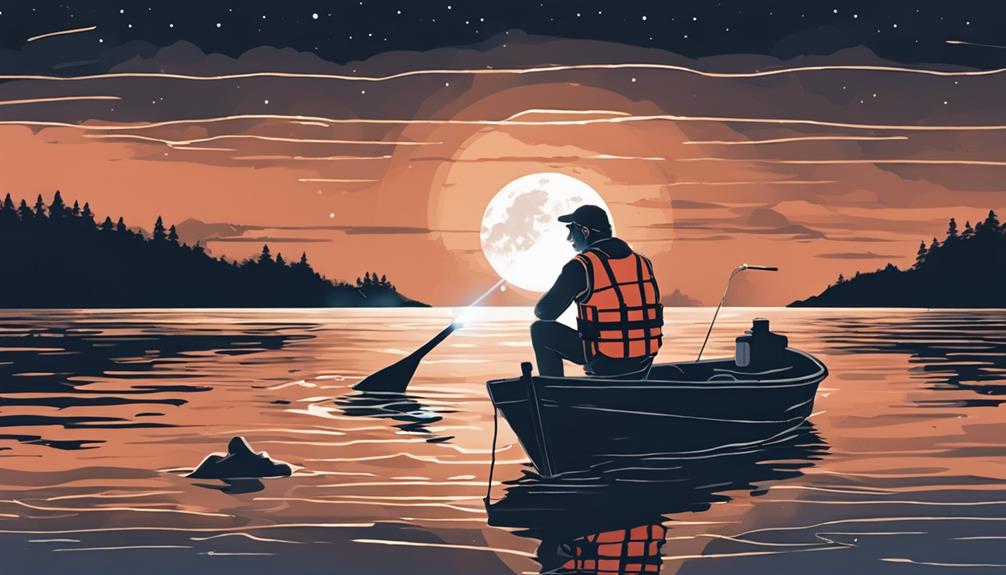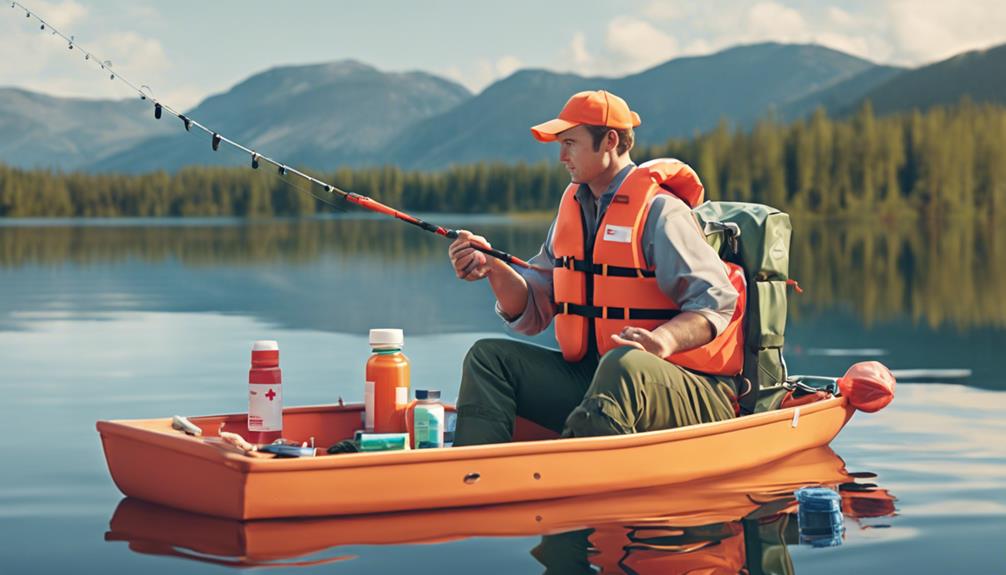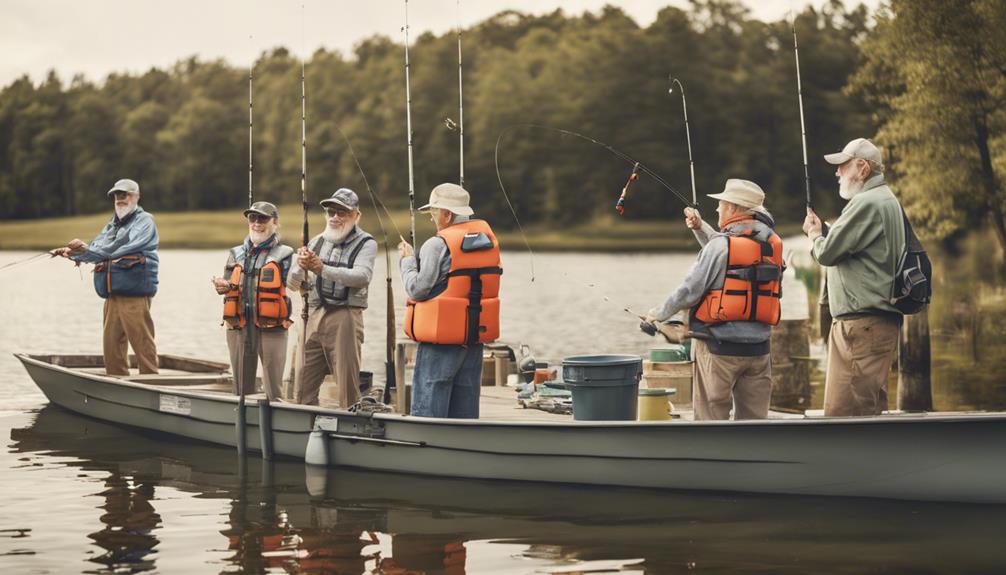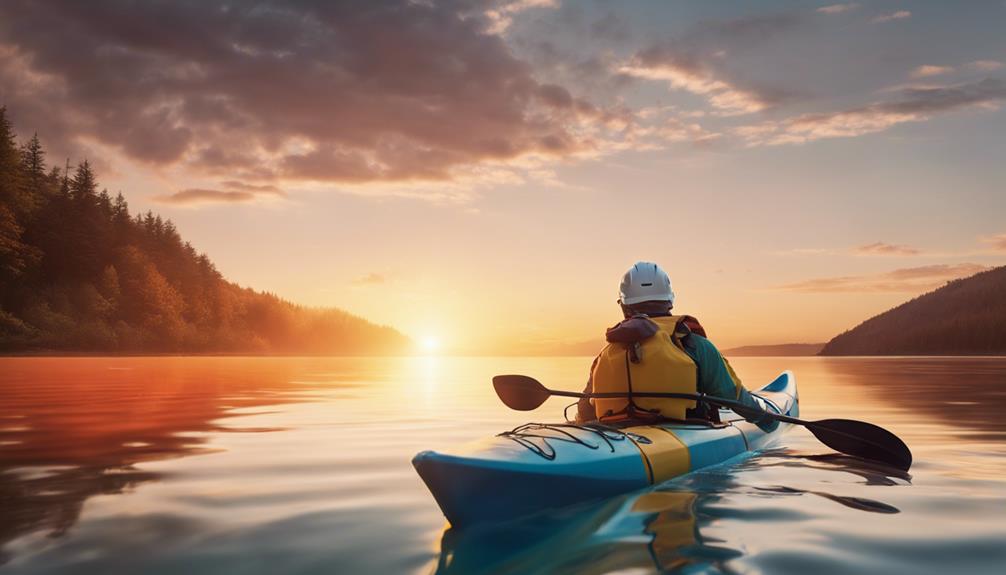When venturing into the mysterious world of night fishing, you might find yourself facing unexpected challenges that require heightened awareness and precaution.
The tranquil darkness that envelops the waters may cloak potential dangers lurking beneath the surface.
It's crucial to remember that safety isn't just a daytime concern—it's a 24-hour responsibility.
Importance of Night Fishing Safety
Night fishing safety is crucial for ensuring a successful and enjoyable fishing experience under the stars. When you head out for a night fishing adventure, visibility awareness is key. It's essential to have a good understanding of your surroundings, including potential obstacles in the water or on the shore. By staying alert and maintaining visibility awareness, you can navigate the night waters safely and effectively.
Distraction management is another vital aspect of night fishing safety. With the peaceful ambiance of the night and the excitement of reeling in a big catch, it's easy to get distracted. However, it's important to stay focused on your fishing tasks and be aware of any changes in your environment. Avoiding distractions won't only help you stay safe but also increase your chances of having a successful fishing trip.
Essential Safety Gear for Night Fishing
When preparing for night fishing, ensuring you have the essential safety gear is paramount for a secure and successful outing. Emergency procedures are a crucial aspect of night fishing safety. Always carry a fully charged cell phone in a waterproof case to contact help in case of emergencies. Additionally, having a first aid kit with basic medical supplies like bandages, antiseptic wipes, and pain relievers is essential. It's imperative to familiarize yourself with the kit's contents and basic first aid procedures before heading out.
Protective clothing plays a vital role in ensuring your safety during night fishing. Wear appropriate clothing for the weather conditions, including moisture-wicking layers to stay dry and warm. Additionally, don't forget to wear a life jacket, especially if you'll be on a boat. Even if you're a strong swimmer, unexpected accidents can happen, and a life jacket can save your life.
Knowing the emergency procedures and having the right protective clothing can significantly reduce the risks associated with night fishing. Prioritize safety by being prepared with the necessary gear to handle unforeseen situations effectively. Remember, being proactive about safety is key to enjoying a successful and secure night fishing adventure.
Tips for Proper Lighting Techniques
To enhance visibility and safety during your night fishing excursions, mastering proper lighting techniques is essential. When it comes to night vision, using red or green LED lights is preferable as they're less disruptive to your eyes compared to white light. These colors help preserve your night vision while still providing adequate illumination for tasks like baiting hooks or navigating the boat.
Utilizing multiple light sources strategically around your fishing area can help eliminate harsh shadows and improve overall visibility. A combination of headlamps, overhead lights on the boat, and portable lanterns can ensure that you have a well-lit environment without causing glare that could hinder your night vision. Positioning these lights to shine downward onto your workspace rather than outward towards the water can also help reduce light pollution and maintain your night vision.
Experiment with different illumination techniques such as using adjustable brightness settings on your lights to find the right balance between visibility and preserving your night vision. Additionally, consider attaching reflective tape to key equipment like fishing rods or coolers to make them easier to locate in the dark. By mastering these lighting techniques, you can create a safe and well-lit environment for your night fishing adventures.
Precautions for Slippery Surfaces
Mastering precautions for slippery surfaces is crucial to avoid accidents and injuries while night fishing. When navigating potentially slick areas in the dark, being prepared and taking necessary safety measures can make all the difference in ensuring a smooth and safe fishing experience.
Key Precautions for Slippery Surfaces:
- Footwear Selection:
Choosing the right footwear is essential when dealing with slippery surfaces. Opt for shoes with good traction and slip-resistant soles to help prevent accidental falls. Additionally, make sure your footwear is comfortable and provides adequate support for long hours of fishing.
- Lighting Precautions:
Proper lighting is key to identifying slippery areas and navigating them safely. Use a reliable and bright light source to illuminate your surroundings, paying special attention to spots that may be wet or covered in algae. By having a well-lit environment, you can spot potential hazards and avoid accidents.
- Surface Grip Safety Measures:
In addition to footwear and lighting, certain safety measures can enhance your grip on slippery surfaces. Take slow and deliberate steps, distributing your weight evenly to maintain balance. When encountering particularly slick areas, consider using non-slip pads or grips to increase traction and stability.
Importance of Proper Navigation Tools
Navigating dark and potentially hazardous areas during night fishing becomes significantly safer and more efficient with the proper navigation tools at your disposal. Having good navigation skills and safety awareness is crucial when venturing out into the waters under the veil of darkness.
One essential navigation tool for night fishing is a reliable GPS system. This device not only helps you pinpoint your exact location but also guides you back to shore with precision. Knowing where you're at all times enhances your safety and prevents you from getting disoriented in the dark.
Another vital tool is a high-quality compass. Even with modern technology, a compass serves as a dependable backup in case your electronic devices fail. It aids in maintaining your sense of direction and heading, allowing you to navigate through the water confidently.
Additionally, having a powerful spotlight or LED navigation lights on your boat is imperative for visibility. These lights not only make you visible to other vessels, but they also illuminate your surroundings, reducing the risk of collisions and helping you spot any obstacles in the water.
Safety Measures for Handling Hooks
Ensure your safety on the water by following essential safety measures when handling hooks during your night fishing excursions. Handling hooks can be tricky, especially in low light conditions, but with the right precautions, you can minimize the risk of accidents.
- Use Pliers for Hook Removal: When a fish swallows the hook or it gets deeply embedded in its mouth, avoid using your hands to remove it. Always carry a pair of fishing pliers in your tackle box for safe and efficient hook removal. Grasp the hook firmly with the pliers and twist or push it out gently to avoid causing further injury to the fish or yourself.
- Know Basic First Aid: Accidents can happen, and being prepared with basic first aid knowledge can make a significant difference in emergencies. If you or someone else gets hooked, stay calm and assess the situation. If the hook is embedded in the skin, don't try to remove it yourself. Instead, seek medical help immediately. In the meantime, cover the hook with a clean cloth to prevent further injury and infection.
- Handle Hooks with Caution: Always handle hooks with caution, whether they're attached to your fishing line or stored in your tackle box. Avoid running your fingers along exposed hooks and store them securely to prevent accidental pricks. Remember, prevention is key to staying safe during night fishing adventures.
Emergency Preparedness for Night Fishing

Being prepared for emergencies while night fishing is crucial for ensuring your safety on the water. When night fishing, it's essential to have a solid plan in place for emergency response situations. Make sure you have a well-stocked first aid kit readily available on your boat. Familiarize yourself with its contents and know how to use them effectively in case of an emergency. Additionally, consider taking a CPR and basic first aid course to be better prepared to handle any unexpected incidents that may arise.
Weather conditions can change rapidly, especially at night, so staying informed about the forecast is vital. Keep an eye on weather updates before and during your night fishing trip. If you notice any signs of a storm approaching, it's essential to have a plan in place to get to shore safely and quickly. Being prepared for adverse weather conditions can help prevent dangerous situations while out on the water.
In case of an emergency, having communication devices like a waterproof flashlight, a whistle, and a fully charged cell phone can be lifesaving. These tools can help you signal for help and alert others to your location. Remember, being proactive and prepared for emergencies while night fishing can make all the difference in ensuring a safe and enjoyable fishing experience.
Significance of Communication Devices
Having reliable communication devices while night fishing is crucial for ensuring your safety on the water. When you're out in the dark, having the right tools can make all the difference. Here's why communication devices are significant:
- Emergency contacts, GPS tracking: Make sure you have a waterproof phone or a VHF radio to contact emergency services or your designated emergency contacts in case something goes wrong. GPS tracking can also help rescuers locate you quickly if needed. Being able to reach out for help can be a lifesaver in critical situations.
- Signal flares, whistle alert: In addition to electronic devices, carry non-electronic signaling tools like signal flares and a whistle. These can come in handy if your primary devices fail or if you need to attract attention in low visibility conditions. The bright light of a signal flare or the piercing sound of a whistle can alert nearby boats or rescuers to your location.
Frequently Asked Questions
Can Using Glow Sticks or Light-Up Bobbers Attract More Fish at Night?
Using glow sticks or light-up bobbers at night can enhance lure effectiveness by attracting more fish. The ambient light levels in the dark can make these visual aids stand out, increasing their visibility underwater.
This heightened visibility can draw in curious fish towards your bait, potentially improving your chances of a successful catch. So, incorporating these glowing accessories into your night fishing routine might just give you that extra edge needed to reel in more fish.
Are There Specific Precautions to Take When Fishing in Areas With High Boat Traffic at Night?
When fishing in areas with high boat traffic at night, it's crucial to prioritize safety. Make sure your boat is highly visible with proper lighting and reflective gear.
Keep an eye out for other vessels and use caution when navigating. Additionally, be mindful of wildlife encounters in the dark.
How Can Weather Conditions Impact the Safety of Night Fishing?
During night fishing, weather conditions play a crucial role in your safety. Moon phases affect visibility, impacting your ability to navigate.
Temperature changes and wind patterns can make the waters rough, posing risks to your boat. Be sure to check weather forecasts and consider how these factors might affect your fishing trip.
Stay vigilant and prepared for any weather changes while out on the water at night.
Is It Necessary to Have a Buddy System in Place for Night Fishing Trips?
When night fishing, it's crucial to have a buddy system in place to stay safe. Solo fishing at night can be risky due to the dangers that come with reduced visibility and potential accidents.
Precautions like having a fishing partner can help ensure someone is there to assist in case of emergencies. Always prioritize safety by utilizing a buddy system to make your night fishing trips as secure as possible.
Are There Any Regulations or Guidelines for Night Fishing That Should Be Followed?
When night fishing, safety regulations and guidelines are crucial for a smooth experience. Proper lighting is essential for night fishing to ensure visibility and avoid accidents.
It's important to follow local regulations regarding night fishing, such as required lighting on boats and specific gear for nighttime angling. By adhering to these guidelines, you can enjoy your night fishing trips safely and responsibly.
Conclusion
In conclusion, night fishing safety is crucial for a successful and enjoyable experience on the water.
By having the right safety gear, using proper lighting techniques, being cautious of slippery surfaces, having navigation tools on hand, handling hooks carefully, being prepared for emergencies, and staying connected with communication devices, you can ensure a safe and rewarding night fishing trip.
Remember, safety should always be a top priority when night fishing.



